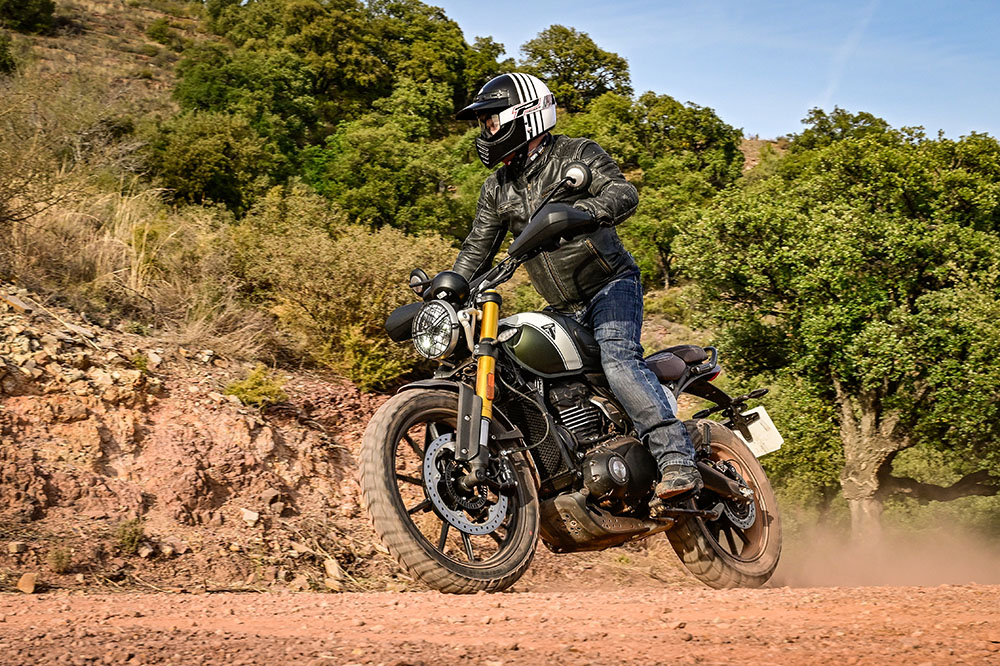Sharing its platform with the Speed 400, Triumph’s Scrambler 400 X is an important motorcycle for Triumph – opening the brand up to a much wider audience, including younger riders and the burgeoning Indian and Brazilian markets.
First impressions of the Scrambler are good, with the bike having plenty of presence and looking more upmarket than its £5,595 price tag would suggest. It clearly takes its styling cues from the bigger 900 and 1200cc Scramblers, although the cast wheels, single front brake disc and low level exhaust system clearly makes it stand out as the baby of the bunch.
But Triumph have really gone to town with its new 400 range, known internally as the TR series. A2 bikes are mass market products built to a price, but where Triumph really stands out is in the quality of componentry and the attention to detail.
Triumph is working with Indian giants Bajaj to help manufacture and distribute the 400 range, but the design and development is pure Triumph and has been carried out by the same people responsible for the bigger bikes in the company’s range.
The 398cc single cylinder engine is a ground up new design and features lots of high end engineering to keep it clean and efficient. Impressively, it has a class leading service interval of 10,000 miles, which should be a real boost for higher mileage riders, and it delivers a claimed 80mpg. In terms of performance, the 39.5bhp Triumph single can’t quite match the power outputs of the parallel twin designs from Kawasaki and Honda, which come in right on the A2 licence limit of 47bhp, nor the KTM/Husqvarna single (also assembled by Bajaj) which puts out around 45bhp, but its lively enough. Top speed should be close to three figures, although there are no official numbers from the manufacturer.
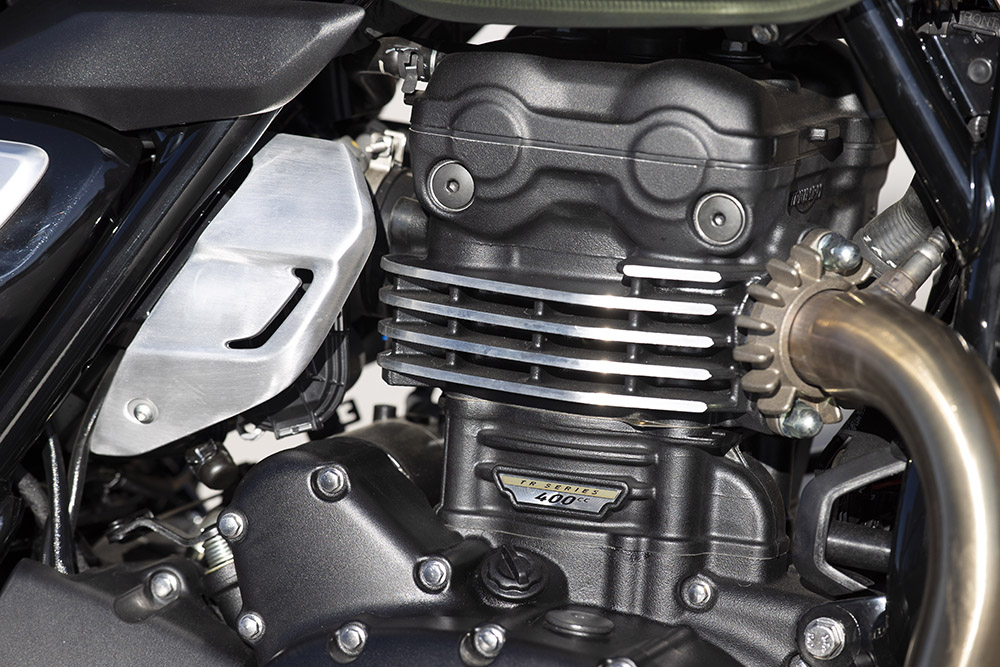
For the past two decades Triumph has focussed all its efforts on making two and three cylinder machines, but the decision to make a single was in part down to saving costs, and in part to allow them to engineer a little more character into the engine. And while it may be the first single to come out of the ‘new’ Triumph company, singles were part of the range for most of the brand’s Meriden era – so the heritage is most certainly there.
If Triumph have saved a few quid by building a single, they’ve more than made up for it in other areas. A2 licence bikes are, by their nature, built to a cost. This can often manifest itself in the form of things like exposed wiring, cheap OE tyres and cycle parts which let down the riding experience. Not so with the Scrambler 400 X, which looks like it’s been built with the same care and attention as the bigger models in Triumph’s Modern Classic range.
One of my favourite things about the range-topping Scrambler 1200 XC we reviewed last year was the way in which many of the modern necessities were hidden out of view by clever engineering and design tricks. Catalytic converters, radiator hoses, fuel injection parts and electrical wiring were largely unseen, while crankcases, cylinder barrels and instrument packs were designed to evoke memories of Meriden’s golden age. It says a great deal about Triumph’s respect for the 400 project that they’ve taken the same approach here.
The liquid cooled 400 gets some fake cooling fins elegantly machined into the cylinder, while the radiator sits elegantly on the frame down tubes with no ugly filler caps or expansion tanks on display. It’s the same with the cabling and water hoses, which are almost completely out of sight. It really does feel like a high quality product, in line with Triumph’s bigger and more expensive products.
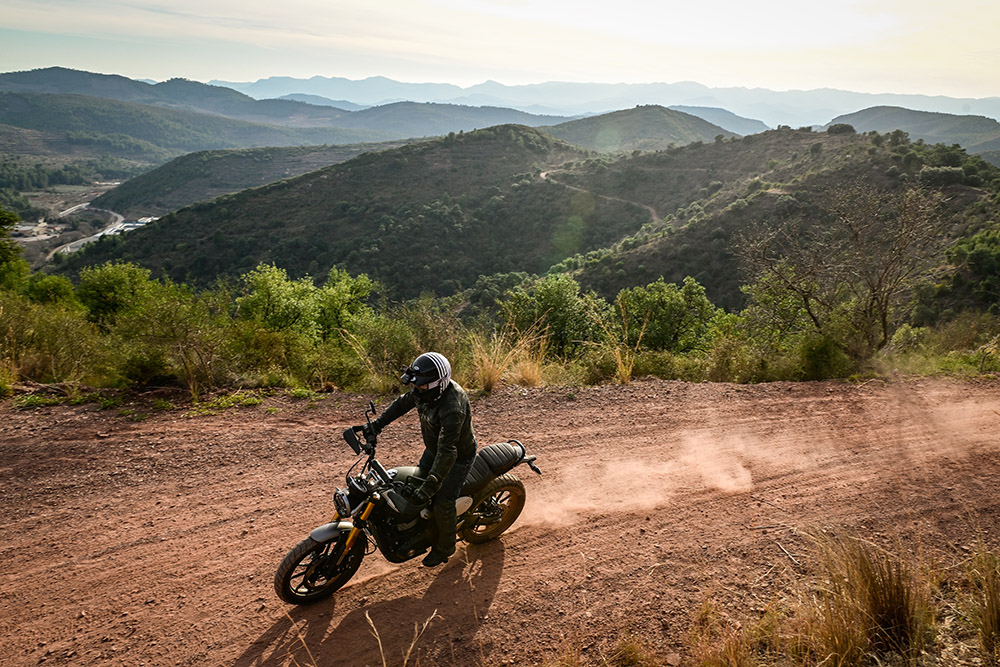
Triumph Scrambler 400 X riding impressions
Hop aboard the 400 X and you’re greeted with a bike which feels more substantial than a ‘mere’ 400.
The tall saddle and wide bars might put off some shorter riders, however the light weight and general narrowness means it is still pretty manageable for most. The flip side is that many will really appreciate having a proper ‘big’ bike, and I think that overall Triumph will benefit from having a physically bigger than average contender in the A2 sector – certainly here in Europe. It does feel like a ‘proper’ bike and this is supported by the general feeling of quality. The touch points all feel good: stuff like the handlebars, switchgear and grips are a big step up from the weedy items which often appear on smaller capacity machines. In particular, I like the chromed Monza style filler cap and the dashboard, which combines a large and very easy to read analogue speedometer with a neat and very comprehensive LCD inset. This features a fuel gauge, gear indicator, fuel consumption read out and a small rev counter.
Not that the rev counter is particularly necessary on a small-ish single, which makes its peak power at 8,000rpm and holds it to the 9,500rpm red line.
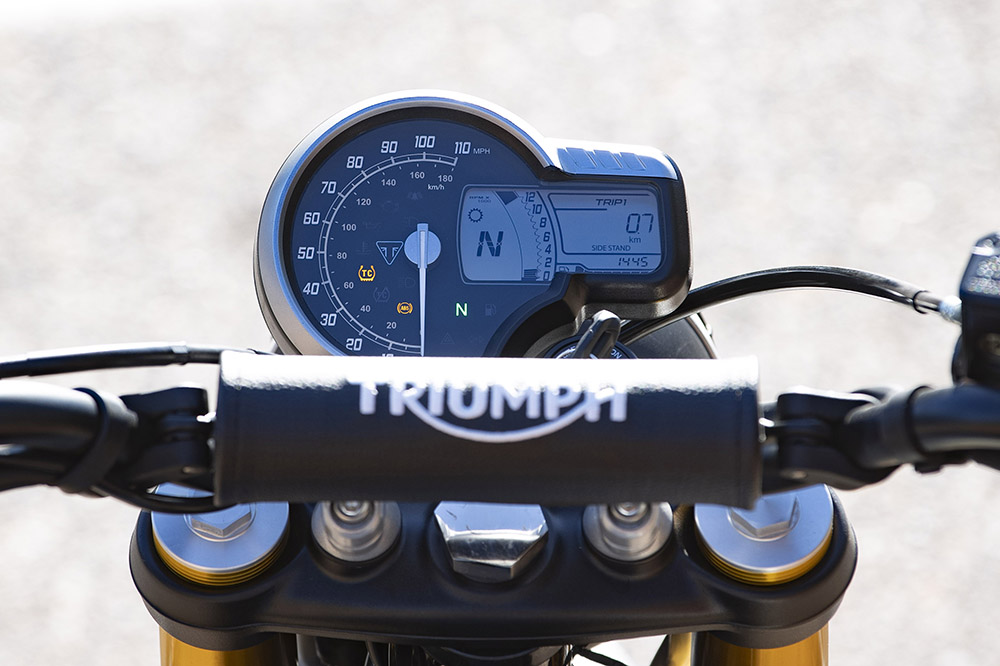
Thumb the starter and it comes to life with a pleasant, if not exactly distinctive, sound. Triumph’s engineers say that they’ve designed to the exhaust system to deliver a rich and evocative sound and, while that might be pushing things a bit, it does have a bit more character than the usual Euro5 single.
Around town it is very easy to ride. The modern ride-by-wire throttle system leads to an incredibly smooth power delivery which, combined with the light clutch, accurate gearbox and tall riding position makes it a really pleasure in traffic.
The engine’s greatest strength is its flexibility. Most of our time with the Scrambler was spent in the mountains around Valencia and after dancing through the (very smooth) gearbox initially I started to get a bit lazy and get the motor to do the work for me. It’s very easy to leave the engine in third, or even fourth, gear. It’s happy pulling out of hairpins in a higher gear than it really should, using the torque and immaculate fuelling to dig it out of the corners. Peak torque of 37.5Nm might be delivered at 6,500rpm, but you’ve got 75% of that pretty much right through the rev range – from below 3,000rpm to over 9,000rpm – and that makes it more relaxing than you would expect a 400 to be. We spent a full day in the saddle of the two Triumphs, racking up around 80 miles on each, and it was much less tiring than I had expected a day on little bikes to be.
On the open road, the Scrambler 400 X is also more fun than you’d expect from a 40bhp motorcycle. Our test ride took place on public roads at the bike’s global press ride in Spain and didn’t give us an opportunity test the top speed, however it will cruise at over 70mph, even up inclines, and I’d suggest something over 90mph should be achievable, where allowed.
The front suspension on the Scrambler 400 X is not adjustable but is of a high quality. The 43mm big piston forks are nicely damped, while there was also nothing untowards to write about when it came to the rear shock, which can be adjusted for preload.
Brakes come from Brembo’s ByBre subsidiary and features a radially mounted four-piston caliper up front, gripping a 320mm disc. The ABS system is inobtrusive in regular riding although I did find the intervention quite extreme when simulating an emergency stop. That said, it’s a great safety feature for inexperienced riders and not really a gripe as much as an observation. The Triumph 400s also have standard traction control, which can be switched off by the rider. The Scrambler version also gets an off-road mode, which disables both the traction control and ABS for riding off the Tarmac. We had an opportunity to try the Scrambler 400 X down some unpaved roads in the Spanish mountains and, while it was a lot of fun, we were on the OE Metzeler Karoo Street tyres running standard road pressures. It’s not really an off-road bike or even as capable as something like the Fantic Caballero 500 Rally we tested recently, but as a simple bike for a big adventure you could definitely do a lot worse.
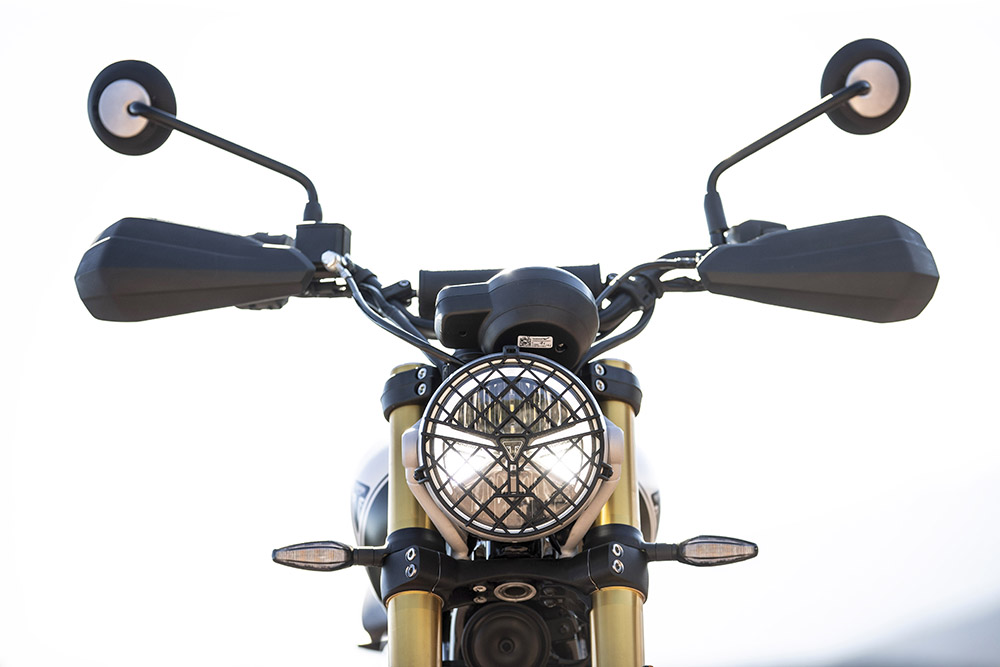
How does the Scrambler 400 X compare to the Triumph Speed 400?
Although based around the same platform, the Speed 400 and Scrambler 400 X have more differences than you might expect. And they feel surprisingly different to ride.
Most visibly the Scrambler 400 X wears a larger the 19” front wheel and has a larger brake disc and longer travel suspension, which combines to create a taller 835mm seat height which will appeal to a slightly different customer base. Beneath the skin, the two bikes have slightly different frames, with the different geometry giving the Scrambler version a longer wheelbase.
The Scrambler gets off-road inspired Metzeler Karoo Street tyres, compared to the Sportecs on the Speed, and an off-road setting for the electronics, which essentially disables the traction control and ABS. Visually, it’s got wider handlebars, with handguards, different colour schemes and graphics, a different exhaust system (which also gives a slightly different tone) and a two piece seat unit. You also get a small belly pan and a headlamp protector grille which, interestingly, is homologated for road use – although we didn’t an opportunity ride at night and get an idea of how well the lights work.
To ride, the Scrambler 400 X definitely feels a good bit different. It feels more substantial and you notice the extra 9kg over the roadster. This does make it a little less agile, however it is offset by a more commanding riding position and the wide ‘bars, which gave added leverage when hustling the bike through the many tight hairpins on our test route.
Triumph reckons there will be a roughly 50-50 split in sales between the Speed 400 and Scrambler 400 X, and it’s as much about personal choice and tastes as to which is ‘better’. Larger riders may have a preference towards the Scrambler, although it is still very accessible to riders of all shapes and sizes with the narrow saddle making it possible for me (165cm) to get one foot flat on the floor, or both feet touching on my tiptoes. Personally I thought the seat comfort was a little better on the Scrambler, however this was offset by a perception of slightly more vibrations at speed. This wasn’t bad, however, and might have been my mind playing tricks as a result of slight fatigue from a long day in the saddle, rather than actually being reality.
Triumph Scrambler 400 X competitors
Although there are plenty of A2 licence motorcycles on the market, there are not too many combining the Scrambler X’s retro lines and pseudo off-road styling.
Husqvarna’s updated-for-2024 Svartpilen 401 carries a near identical price tag and features a funky combination of futuristic styling with retro touches and off-road inspired spoked wheels and tyres. The Husky delivers more power from its KTM-derived engine and electronics package, making it a compelling proposition.
We’ve reviewed Royal Enfield’s Scram 411 in the past and, although it’s cheaper, it doesn’t come close to the Triumph’s performance and specification. At the other end of the market, Fantic’s Caballero 500 Scrambler is a niche model worth considering, although you’ll need a strong deal to bring it into the Scrambler 400 X’s price range. Other single cylinder offerings include BMW’s G 310 GS and the KTM 390 Adventure, although neither can offer the classic styling of the Scrambler 400 X.
The A2 category is full of great twin cylinder competition too. We enjoyed riding the scrambler styled Honda CL500 last summer and although it’s 10% more expensive than the Triumph, the 471cc twin delivers the full 47bhp allowed under A2 laws, giving it a touch more performance.
Conclusion
There’s a lot to like about Triumph’s new 400 range. They bring a level of build quality and attention to detail never before seen in the A2 category, with the Scrambler 400 X in particular appealing to a wide range of riders. Triumph themselves see this and the Speed 400 selling to younger riders and customers in emerging markets like Brazil and India, but it would be a real surprise not to see more than a few finding homes with older and more experienced bikers.
The beauty of the Scrambler 400 X is that it feels much bigger than the capacity and price would suggest. Its DNA is pure Triumph and it can hold its head up at any bike meet. It may not be quite the bargain of the Speed 400, but it’s priced to sell and will undoubtedly do so in large numbers. Triumph’s first attempt at a dedicated A2 motorcycle is an absolute corker. Top work lads.
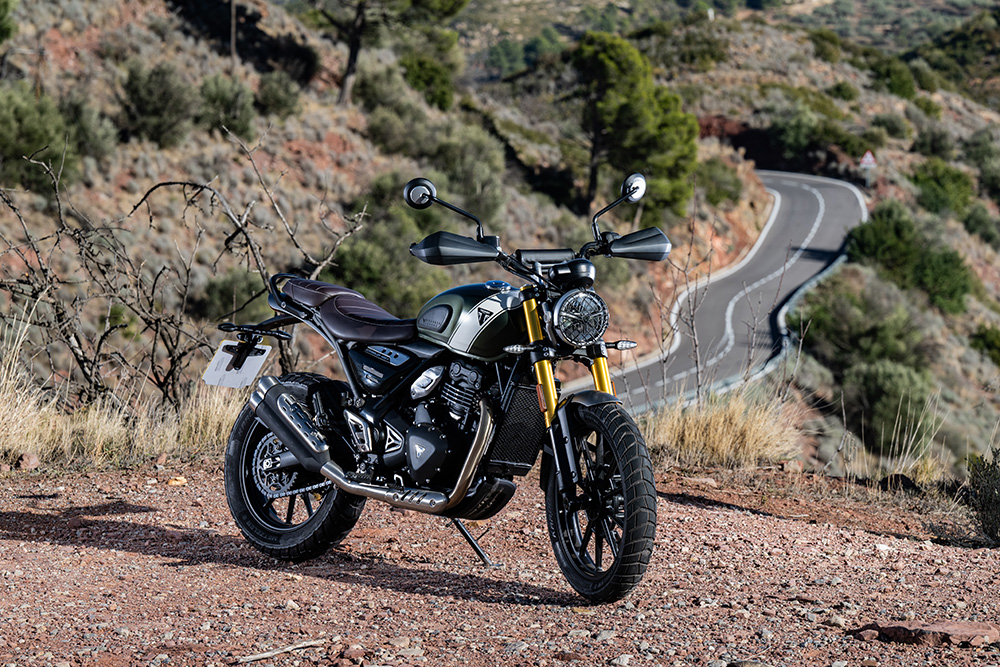
Triumph Scrambler 400 X specification
Price: £5,595
Engine: 398cc, liquid cooled, DOHC, four-valve, single cylinder
Power: 39.5bhp @ 8,000rpm
Torque: 37.5Nm @ 6,500rpm
Suspension: 43mm upside down big piston forks. Single gas monoshock rear with external reservoir and preload adjustment
Wheels: 10 spoke cast aluminium, 19” front and 17” rear
Tyres: Metzeler Karoo Street. Front 100/90-19, rear 140/80-17
Weight: 179kg (wet)
Seat height: 835mm
Fuel tank: 13 litres
Contact: www.triumphmotorcycles.co.uk


